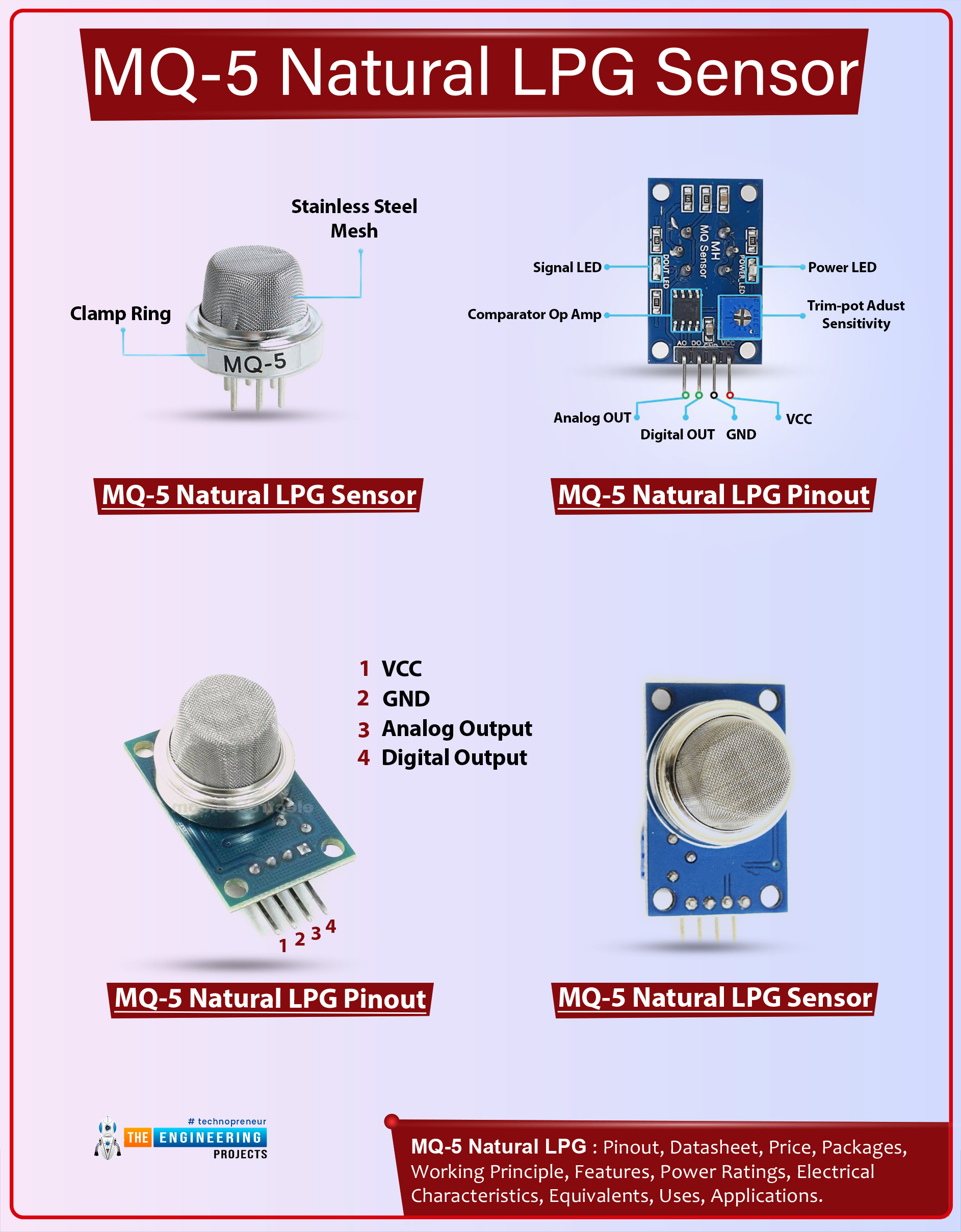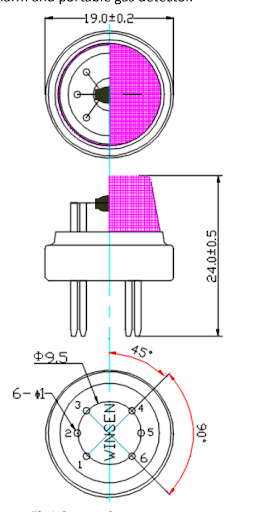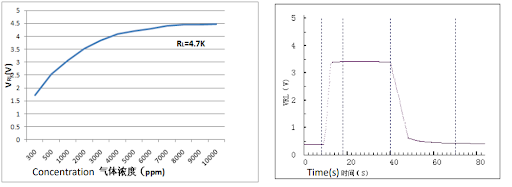
Hi readers! Welcome to another article where we are discussing the MQ family members. Today, our motto is to learn about the MQ-5 natural liquified petroleum gas (LPG) sensor. The gas sensing material used in this sensor is known as tin dioxide(SnO2). It detects the natural LPG in the surroundings as soon as the core material of this sensor comes in contact with the LPG. This will be explained in simple words in this article.
Today, we’ll start learning about the basic introduction of the MQ-5 natural LPG sensor. After that, we’ll move towards its datasheet element, where we are going to see the specifications and features of the sensor, along with the pinout configuration and internal structure. We’ll also see the working principle and applications of the MQ-5 natural LPG sensor, and all the information will be shown by using tables, descriptions, and images for the best concepts.
So, let’s dive into the first topic to move forward:
MQ-5 Natural LPG Sensor Introduction
The MQ-5 natural LPG sensor belongs to the class of sensors that are used for the detection of different gases. The MQ-5 natural LPG sensor can detect multiple gases with the help of the semiconductor material tin dioxide (SnO2) present in its basic structure. This material has low conductance in pure gas (with no natural LPG), but as soon as it comes into contact with the natural LPG, the electrical conductance decreases, which is indicated through the output pin of this sensor. The simple circuit of this sensor converts this change in conductivity into a voltage change, and as a result, these sensors can send the signal to other components of the circuit to stimulate the system.

Here is a simple list of the detectable gases using an MQ-5 natural LPG sensor:
- Propane (C3H8): MQ-5 has the highest sensitivity for propane gas, making it suitable for propane leak detection. This is the primary gas for MQ-5 natural LPG sensor detection.
- Methane (CH4): The sensor has some sensitivity for methane as well, but not as precise as dedicated methane sensors. If the user wants to have a highly precise sensor for methane, then MQ-4 is a better option.
- Butane (C4H10): The butane gas is also detected using this sensor if the gas includes Liquefied Petroleum Gas (LPG).
- Alcohol (C2H5OH): For alcohol gas, this sensor has limited sensitivity. It is not ideal for precise alcohol measurements, but if the user wants a precise result, they can use the MQ-3 sensor.
- Hydrogen (H2): The MQ-5 has some sensitivity for hydrogen presence as well, but potential interference from other gases.

MQ-5 Natural LPG Sensor Datasheet
Before going into the details of its external structure, it is better to know about the internal features and specifications of this product. Here are some important features of the MQ-5 sensor that make it a good choice for natural LPG detection:
MQ-5 Natural LPG Sensor Features
The first and most obvious feature of this sensor is, that it is highly sensitive to propane (C3H8); therefore, the primary goal of this sensor is to detect any liquified petroleum gas (LPG).
The internal structure is designed in such a way that it responds to the LPG as soon as the sensitive internal material comes into contact.
It requires simple additional circuitry to create the whole system, and its design is easy to integrate with other components.
It has low power consumption and, therefore, is a suitable component of projects like the Internet of Things (IoT). Here, it can work continuously, and the simple structure is the reason behind its long life.
It provides stable results and readings over time and, therefore, is a reliable component.
MQ-5 Natural LPG Sensor Specifications
Parameter |
Value |
Units |
Sensor Type |
Semiconductor |
N/A |
Standard Encapsulation |
Bakelite, Metal cap |
N/A |
Target Gas |
LPG, CH4 |
N/A |
Detection Range |
300 - 10000 ppm (CH4, C3H8) |
ppm |
Loop Voltage (Vc) |
≤ 24 V |
DC |
Heater Voltage (VH) |
5.0 V ± 0.1 V |
AC or DC |
Load Resistance (RL) |
Adjustable |
N/A |
Heater Resistance (RH) |
26 Ω ± 3 Ω |
(room temp.) |
Heater Consumption (PH) |
≤ 950 mW |
N/A |
Sensitivity (S) |
Rs(in air) / Rs(in 2000 ppm C3H8) ≥ 5 |
N/A |
Output Voltage (Vs) |
2.5 V - 4.0 V |
(in 2000 ppm C3H8) |
Concentration Slope (α) |
≤ 0.6 (R3000ppm/R1000ppm C3H8) |
N/A |
Standard Test Conditions |
||
Temperature (Tem) |
20°C ± 2°C |
N/A |
Humidity |
55% ± 5% RH |
N/A |
MQ-5 Natural LPG Sensor Structure
Before going into the details of the external structure, let’s have a look at the internal structure of this sensor:

The image shown above displays the structure of the dimension from different angles of the sensor. The unit here is a millimeter, and all the readings have a tolerance:±0.1mm. We’ll learn the detailed dimensions soon in this article.
MQ-5 Natural LPG Sensor Basic Circuit
An important feature of this sensor is its simple circuit, which not only makes it less power-consuming but also allows the user to install it without any complications. Here is the basic structure of this LPG sensor:

The labeling of the image will be clarified in the next section when we study its structure in detail.
If you want to study the datasheet in more detail then I suggest you visit the following link:
MQ-5 Natural LPG Sensor Pinout Configuration
Just like most of the gas sensors of this class, MQ-5 has four pins. In some models, the additional two pins are also present. It has a simple structure, and the detail of each pin is given in the table below:
Standard Configuration |
Alternative Configuration |
Function |
A |
AO (Analog Out) |
Analog Output |
H |
H (Heater) |
Heater Power |
GND |
GND (Ground) |
Ground |
VCC |
VCC (Power) |
Power Supply |
N/A |
DO (Digital Out) |
Digital Output (optional) |
N/A |
A (Analog Ground) |
Analog Ground (optional) |
MQ-5 Natural LPG Sensor Packages
A plus point of this series is, the gas sensors come in different packages so that the user may choose MQ-5 natural LPG sensor according to the type of circuit. Each package has its own pros and cons. Here are some important packages in which this sensor is available:
Package Type |
Description |
Advantages |
Disadvantages |
DIP |
Through-hole mounted |
Simple and affordable |
Not suitable for space-constrained applications |
SMD |
Surface-mount |
Ideal for space-constrained applications |
Requires soldering expertise |
Custom Module |
Pre-assembled module |
Easy to use |
Most expensive |
MQ-5 Natural LPG Sensor Alternatives
Some other gas sensors from the MQ series can be used in place of the MQ-5 natural LPG sensor, but these may not be that efficient. Here are some popular gas sensors that can be used in place of MQ-5 natural LPG sensors:
- Semiconductor sensors (propane, butane, and carbon monoxide)
- Metal oxide semiconductor (MOS) sensors (ammonia, hydrogen sulfide)
- NDIR (non-dispersive infrared) sensors (methane, CO2)
- Catalytic bead sensors (combustible gases)
Where to Buy MQ-5 Natural LPG Sensor
The electronic components are sensitive, and the performance depends on the circuit and the manufacturing features. If you want to get the best MQ-5 natural LPG sensor, you must buy it from the following platforms:
eBay
AliExpress
Amazon
MQ-5 Natural LPG Sensor Working Principle
The MQ-5 sensor has a similar working as other gas sensors from the MQ series. The sensor detects LPG and methane gases through the semiconductor metal oxide sensing layer. Here is the breakdown of the work into different steps:
MQ-5 Natural LPG Sensor Heating Process
The MQ-5 has a heating element in its core that is constantly powered. Typically, it is done on the 5V and this heating enables the sensing layer to absorb more gas molecules from its surrounding air. Usually, the sensing element is tin dioxide (SnO2) because it is an excellent receptor of flammable gases.

MQ-5 Natural LPG Sensor Ion Creation
The constant heating allows the reactive material to absorb oxygen and create oxygen ions on its surface. In this way, these ions are readily available for the flammable gases needed for the reaction. As a result, a depletion region is formed around the tin oxide so that the electrical resistance of the circuit increases.
MQ-5 Natural LPG Sensor Gas Adsorption
As soon as the reactive gases (LPG) come into contact with the oxygen ions, these start reacting with the liquified petroleum gas. This results in a decreasing number of ions and a decrease in electrical resistance. We know that the electric current is inversely proportional to the resistance so the overall electrical conductivity of the circuit is affected, which causes the sensing of the gas.
MQ-5 Natural LPG Sensor Analogue Values
The circuit is designed in such a way that the change in the current values stimulates the analog output that can be detected at the analog pin as an output.
MQ-5 Natural LPG Sensor Digital Output
Some models of MQ-5 have a digital output as well. The change in the electrical current causes a change in the voltage difference between the diodes of the circuit. This voltage change is detected on the digital pin of the MQ-5 natural LPG sensor. This happens because the circuit has an analog to a digital converter.
The voltage change typically ranges from 2.5V to 4.0V. As the concentration of the LPG and other reactive gases increases, it causes a change in the electrical conductance and as a result, less voltage change is seen.
MQ-5 Natural LPG Sensor Physical Dimensions
A feature of this sensor is its small and compatible size, which can fit in different circuits. Here are the dimensions of the MQ-5 natural gas sensor that will help you work with it in a circuit:
Dimension |
Value |
Units |
Diameter |
20 |
mm |
Height |
30 |
mm |
Pin length |
4-5 |
mm |
Weight |
~8 |
grams |
Mounting Hole Distance |
18 |
mm |
Pin Pitch |
2.54 |
mm |
MQ-5 Natural LPG Sensor Applications
There are different ways to use this sensor in applications. This is a common gas sensor in different domains of daily life. The basic and most common examples of its applications are given here:
Industrial flammable gas alarm
Portable gas detector
Domestic gas leakage alarm
Air quality monitor
Educational projects
Smart home devices
Robotics
Automotive
Agriculture
Healthcare
Hence, in this way, we have studied the mQ-5 natural LPG sensor in detail. We started this learning through the basic introduction of this sensor. We saw that it can detect multiple gases but it is most precise for the MQ-5 natural LPG. We studied the basic features and specifications through its datasheet and saw different graphs to understand its working. Just after that, we understood the pin configuration and working principle of this sensor. In the end, we saw the table for the physical dimension and the applications of this gas sensor. I hope I have covered all the topics but if you want to learn more, you can ask us.



